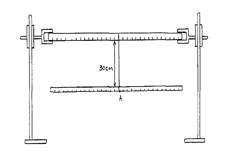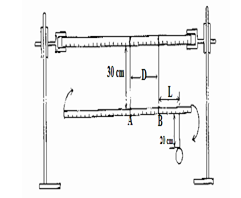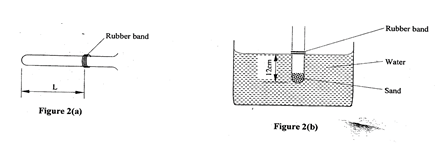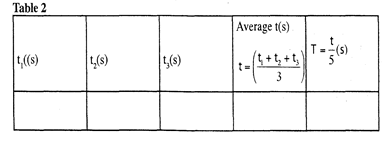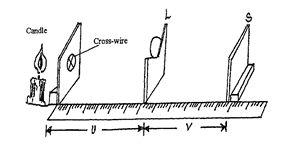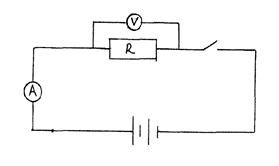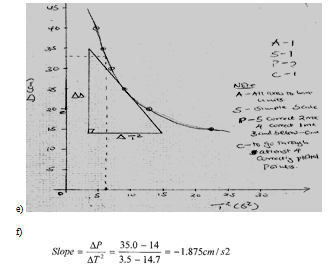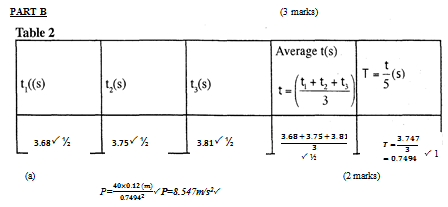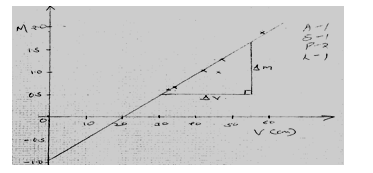QUESTION 1;
This question consists of two parts A and B; attempt both parts.
PART A
You are provided with the following:
- Two metre-rules.
- A stopwatch.
- A half metre rule.
- Two retort stands, two bosses and two clamps.
- Some sewing thread.
- A pendulum ball.
Proceed as follows:
- Clamp one metre rule horizontally on the two stands so that it is on a vertical plane. Suspend the second metre rule so that it balances on one point as shown in figure 1 below. Note the balance point as the centre of gravity of the metre rule. Let this be point A.
- Set the length of the string on which the metre rule is suspended to be 30cm. Tie a second support to the metre rule a distance D from the string. Let the point of support be point B
- Suspend the pendulum ball with a string a distance L from B and set the length of the string to 20cm. See figure 2 below. Starting with a distance D = 15cm, and distance L = 25 cm. displace the hanging metre rule on a horizontal plane and record the time taken for it to make 20 complete oscillations on table 1.
- Repeat part (c) above for other values of D and complete the table below. (5marks)
D (cm)
Time for 20 oscillations (S)
Periodic time (T) (S)
T2 (S2)
15
20
25
30
35
40
- plot a graph of D (cm) against T2. (5marks)
- Determine the slope of the graph at D= 25cm. (3marks)
- Use your graph to determine the periodic time when the length of distance D is 33cm.
PART B ;
You are provided with the following:
- A cylindrical container (about 20cm high and diameter 8cm or more)- used plastic containers can be used by cutting the upper section
- Some water
- A stop watch
- Ametre rule or half-metre rule
- A boiling tube
- Somesand (in 100ml beaker)
- Spatula
- A rubber band
Proceed as follows:
- Tie the rubber band round the boiling tube so that it is at a distance L =12 cm from the bottom of the tube (see fig 2a). Pour water into the cylindrical container until the level is about 2.0 cm from the top of the beaker. Float the boiling tube in the water in the container. Add sand gradually into the boiling tube until the tube sinks to the 12 cm mark. See figure 2(b).
- Depress the boiling tube slightly and release so that it oscillates vertically without touching the sides of the container. Measure and record in table 2 the time t1, for five oscillations of the boiling tube. Repeat the procedure two more times to obtain t2 and t3 and record the values in table 2. Complete the table. (3 marks)
- Evaluate P=40L/T2 given that L is the length of the tube in metres up to the rubber band in part (i) and Tis the value obtained in (ii) above. (2 marks)
QUESTION 2;
PART A
You are provided with the following apparatus
- A metre rule
- A log of plasticine
- Bi convex lens
- A candle
- A lens holder
- Across wire mounted on a cardboard
- A white screen
- Determine the focal length of the lens using a distance object.
f=…… (1mark) - Set up the apparatus as shown.
- Starting with u=30cm, vary the position of the screen S until a sharp image of the cross wire is observed on the screen. Measure and record the value o the image distance v.
- Repeat the experiment above for other values of u35cm, 40cm, 50cm, and 55cm. (4marks)
U (cm)
30
35
40
45
50
55
V(cm)
M =v/u
- Plot a graph of M against v. (5marks)
- Determine the slope of the graph. (3marks)
- The equation of the graph is given by M = v/f-1,use the graph to obtain the value of (3marks
- Determine the focal length of the lens using a distance object.
QUESTION2 :PART B
You are provided with the following apparatus.
-2 new dry cells size D
-A cell holder.
- 1 switch
-1 Voltmeter 0 - 3V.
- 1 Ammeter 0-1A,
- 8 connecting wires (4 with at least 1 crocodile clip).
- Resistor wire mounted on cardboard.R
- Connect the circuit as shown below in figure 4.0.
Record the reading of- Ammeter, I=…A(1mark)
- Voltmeter, V=……V (1mark)
- Given that K =v/l , find K=…… (2marks)

MARKING SCHEME
|
D (cm) |
Time for 20 oscillations (S) |
Periodic time (T) (S) |
T2 (S2) |
|
15 |
94.00 |
4.70 |
22.09 |
|
20 |
70.91 |
3.546 |
12.57 |
|
25 |
60.60 |
3.03 |
9.181 |
|
30 |
53.43 |
2.672 |
7.139 |
|
35 |
47.87 |
2.394 |
5.731 |
|
40 |
44.62 |
2.231 |
4.977 |
½ each 2dp amust1mk for all exact values 1mk for all correct-3sf
f = 20 ± 0.1 cm
|
U (cm) |
30 |
35 |
40 |
45 |
50 |
55 |
|
V(cm) |
58.0 |
47.0 |
42.0 |
46 |
34.5 |
32.5 |
|
M = |
1.933 |
1.343 |
1.05 |
1.022 |
0.69 |
0.5909 |
- Use the x intercept , When M = 0, v = f. ,Or reciprocal of slope =f.
-
- Ammeter, I = 0.25 A
- Voltmeter, V = 2.7 V
- K =10.8ῼ
Download PHYSICS PAPER 3 - KCSE 2019 JOINT PRE MOCK EXAMINATION NAMBALE.
Tap Here to Download for 50/-
Get on WhatsApp for 50/-
Why download?
- ✔ To read offline at any time.
- ✔ To Print at your convenience
- ✔ Share Easily with Friends / Students

